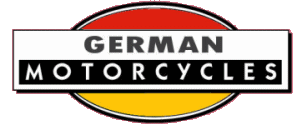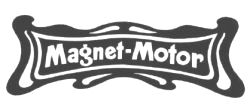


Motorenfabrik Magnet GmbH was established in 1900 [1] at Lehderstrasse 15 - 19 Berlin-Weißensee and the first motorcycles were produced in 1901.
Early models were large singles followed by a V-twin, and in 1910 they introduced a vertical twin. The company then moved to Berlin-Halensee and added cyclecars to the range, and in 1911 offered the model "Selbstfahrer" which was a tri-car somewhat similar to the later Scott Sociable and Bradshaw Seal.
Dreirad (three-wheeler) models were also built in both passenger and commercial forms, some with their own 3.25 h.p four-stroke engines which had friction clutch and chain drive. In 1909 a machine named the Magnet-Wagen was offered, with a 498cc V-twin mounted above the front wheel.
After the Great War motorcycle and dreirad production continued, with some of the three-wheelers fitted with much larger four-cylinder engines of up to 20 h.p. The business did not prosper due to the harsh economic climate, and vehicle production ceased in 1926. Magnet himself died in 1924.
The firm continued to build engines, particularly marine engines of up to six cylinders, until the Second World War.
ALTHOUGH Magnet motor cycles are among the most successful mechanically propelled bicycles in Germany, little has been heard of them on this side of the water. These machines possess some very interesting features, and we illustrate two of the many models which most conform to British ideas. The first machine illustrated is of 3½ h.p., the cylinder dimensions being 84 mm. by 82 mm., and a low-tension magneto is used. A two-speed gear and free engine is fitted on the counter-shaft of patented design, with a combined belt and chain drive. There are no pedals, foot plates being provided in their stead. A rigid pattern sidecar is shown attached to the bicycle, and a special form of supplementary handle-bar to enable the driver to sit in the passenger's seat and control the machine when he so desires.
The second model is a twin-cylinder 5 h.p. mount, cylinder dimensions 70 mm. by 82 mm. The inlet valves are mechanically operated on the machine by means of overhead tappet rods. Another interesting point is that two magnetos are fitted - one in front and one at the rear of the crank case. The standard tyres are 24in. by 2½ in., and the total weight of the machine is given as 170 lbs. Other models are a 2 h.p. lightweight machine and a trade tricycle.
Further particulars can be obtained from the representative in the United Kingdom, H. D. Martin, 18, Red Lion Passage, Holborn. W.C.
The Motor Cycle February 26th, 1908
Sources: François-Marie Dumas, Scalerandi, Mortons, Axel Oskar Mathieu Archive.
Notes
1. AOM gives founding date of 1906.
If you have a query or information about Magnet motorcycles please contact us